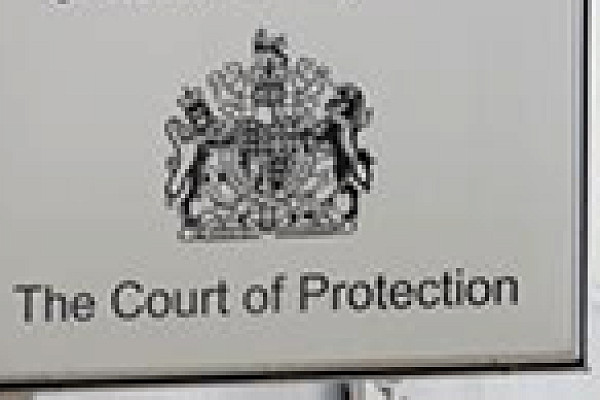

The final say
News
Must read
Families refusing access to support
Features Test

Producing robust capacity assessments and the approaches to assessing capacity

Disability discrimination and proportionality in housing management

Cross-border deprivation of liberty

Dealing with unexplained deaths and inquests

Court of Protection case update: May 2025
Features

Producing robust capacity assessments and the approaches to assessing capacity

Disability discrimination and proportionality in housing management

Cross-border deprivation of liberty

Dealing with unexplained deaths and inquests

Court of Protection case update: May 2025
Sponsored articles
What is the role of the National Trading Standards Estate & Letting Agency Team in assisting enforcement authorities?
Webinars
Is Omeprazole the new EDS?
More features
Provision of same-sex intimate care
Court of Protection case update: April 2025
High Court guidance on Article 3 engagement in care at home cases
‘Stitch’, capacity and complexity
Issuing proceedings in best interests cases
Court of Protection case law update: March 2025
The Health and Social Care (Wales) Bill Series – Regulation and Inspection of Social Care
The Health and Social Care (Wales) Bill Series – Direct Payments for NHS Continuing Healthcare
What is the right approach to Care Act assessments?
Disabled people in immigration bail: the duties of the Home Office and local authorities
Capacity, insight and professional cultures
Court of Protection update: February 2025
Setting care home fees
Could this be the end for local authority-provided residential care?
“On a DoLS”
It’s all about the care plan
Court of Protection case update: January 2025
Mental capacity and expert evidence
Best interests, wishes and feelings
Capacity, sexual relations and public protection – another go-round before the Court of Appeal
Court of Protection Update - December 2024
Fluctuating capacity, the “longitudinal approach” and practical dilemmas
Capacity and civil proceedings
Recovering adult social care charges via insolvency administration orders
Court of Protection case update: October 2024
Communication with protected parties in legal proceedings
The way forward for CQC – something old, something new….
The Ombudsman, DoLS and triaging – asking the impossible?
Outsourcing and the Human Rights Act 1998 – the consequences
Commissioning care and support in Wales: new code of practice
In the best interest - part two
- Details
In the second of a three-part series on best interests decisions on personal welfare applications in the Court of Protection and the High Court over the last twelve months, Victoria Butler-Cole and Alex Ruck Keene examine important rulings covering the MCA 2005 and the Mental Health Act 1983, consent to sexual relations, use of the inherent jurisdiction for vulnerable adults, the interplay between the Court of Protection and judicial review, and jurisdiction.
Mental Capacity Act 2005 and Mental Health Act 1983
Two recent cases have considered the interrelationship between the MCA 2005 and the Mental Health Act 1983:
W Primary Care Trust v TB & Ors [2009] EWHC 1737
In this case, the applicant Primary Care Trust sought a declaration that TB was eligible to be deprived of her liberty at a particular establishment pursuant to an authority under the Mental Capacity Act 2005 s.4A. The care home was registered under the Care Standards Act 2000. The court was required to determine whether, assuming residential treatment at the care home was in TB's best interests as defined by the 2005 Act, depriving her of her liberty in order to provide that treatment could be authorised under s.16 or Sch.1A of the 2005 Act.
Roderick Wood J found that s.16A of the 2005 Act circumscribed the powers of the court to make a welfare order which incorporated an element of deprivation of liberty. If, by operation of s.16A, TB was ineligible to be deprived of her liberty under the Act, then the only option for detaining her would be under the 1983 Act. However, if that route were taken, she could not be detained at the care home because it did not accept patients under the 1983 Act. It was accepted that it would not be helpful to detain TB under the 1983 Act because the specialist treatment she required would not be available in mainstream psychiatric services. TB fell within "Case E" under Sch.1A para.2 of the 2005 Act. Therefore, she would be ineligible to be deprived of her liberty if the conditions in Sch.1A para.5 were met, namely that the relevant instrument authorised her to be a "mental health patient" and she objected to being a mental health patient.
The judge went on to find that, as the care home was not registered as an independent hospital, nor was it part of the NHS, it did not fall within the definition of a "health service hospital" in the relevant provisions of the 1983 Act. Therefore, the declaration sought by the PCT did not constitute a declaration or order seeking to have TB "accommodated in a hospital" as thus defined. Accordingly, she was not on that basis a "mental health patient" as defined under Sch.1A para.16 of the 2005 Act. Her detention at the care home fell outwith the categories of ineligibility under Sch.1A para.2. Therefore, an order under the Act could be made if there was sufficient evidence to establish her best interests construed in the light of all the circumstances.
GJ v The Foundation Trust [2009] EWHC 2972 (Fam)
The particular question posed by this case was how to determine whether someone was eligible to be deprived of their liberty under the MCA 2005 in a hospital, when they were potentially treatable under section (under the MHA 1983).
The judge stated that the MHA 1983 is the primary legislation, in the sense that if treatment is required and can be given under the MHA 1983, it is not for a professional to decide that it would be preferable to proceed under the MCA 2005. The relevant question is therefore whether the person would be detained in hospital for treatment for his mental disorder if it were not for the need for treatment of his physical disorder.
If the answer is yes, then the person falls within the scope of the MHA 1983, and the decision-maker must then ascertain whether he objects to the proposed deprivation of liberty. If he does, he will be ineligible to be deprived of his liberty under the MCA 2005. If the answer is no, the person is only being detained for treatment of his physical disorder not his mental disorder, then he is not a ‘mental health patient’ for the purposes of the MCA 2005 and so the ineligibility rules in Schedule A1 paragraph 5 do not apply to him.
As demonstrated by both of these cases, the relationship between the MHA 1983 and the MCA 2005 is complex, and the provisions of Schedule A1 to the MCA 2005 somewhat difficult to apply. Local authorities will need to be particularly careful about issuing authorisations under DOLS in respect of patients who may meet the criteria for sectioning under the MHA 1983.
Consent to sexual relations
In Re C [2009] UKHL 42 there was a criminal appeal concerning the correct interpretation of part of the Sexual Offences Act 2003. In the course of considering the criminal test for capacity to consent to sexual relations, the House of Lords also considered the judgment of Munby J (as he then was) in X City Council v MB [2006] EWHC 168 (Fam) which dealt with the common law test for capacity to consent to sexual relations.
Baroness Hale said that she was ‘far from sure’ that the comments expressed by Munby J in MB were correct, but the issue was not decided as the question of the correct common law test did not fall to be decided. Her comments however leave some doubt as to the correct approach for assessing capacity to consent to sexual relations under the MCA 2005.
Munby J had concluded in MB that the threshold for capacity to consent to sexual relations was very low – merely the ability to understand the nature of the act itself. Baroness Hale suggested that this approach failed to recognise properly the need for a person to be able to weigh up issues involved in making a decision. She gave the example of an individual who had delusions she was being commanded by God to have sexual intercourse: the individual might well understand the act, but not be deemed to have capacity to consent to it, in that she was not making an autonomous choice. Baroness Hale said that whereas Munby J had found that capacity to consent to sexual relations was not situation specific, ”in fact, it is difficult to think of an activity which is more person and situation specific than sexual relations” (para 27).
The implications of the judgment for local authorities may be important. In cases in which vulnerable adults whose capacity is in question are involved or may be involved in sexual relationships, it will be very important that those assessing capacity are familiar with both MB and R v C. Pending further clarification by the courts as to the appropriate test at common law, it may be prudent to apply the more stringent test suggested by R v C than to rely on the very low threshold set in MB.
Use of the inherent jurisdiction for vulnerable adults
In Re SA [2005] EWHC 2942 (Fam), the High Court said that in certain circumstances, adults without capacity could nevertheless be the subject of best interests decisions under the inherent jurisdiction. In SA, Munby J set out the nature of the court’s jurisdiction as follows:
“77. It would be unwise, and indeed inappropriate, for me even to attempt to define who might fall into this group in relation to whom the court can properly exercise its inherent jurisdiction. I disavow any such intention. It suffices for present purposes to say that, in my judgment, the authorities to which I have referred demonstrate that the inherent jurisdiction can be exercised in relation to a vulnerable adult who, even if not incapacitated by mental disorder or mental illness, is, or is reasonably believed to be, either (i) under constraint or (ii) subject to coercion or undue influence or (iii) for some other reason deprived of the capacity to make the relevant decision, or disabled from making a free choice, or incapacitated or disabled from giving or expressing a real and genuine consent.”
In Re JK (unreported, July 2009), however, the Official Solicitor argued that this jurisdiction was very limited and should only be exercised very sparingly. The court declined to hold that the individual concerned met the test of being a vulnerable adult. It remains to be seen in which cases, other than those involving forced marriage (as was the case in SA) the High Court will be willing to exercise its inherent jurisdiction.
Local authorities should therefore be aware than where someone is judged to be a vulnerable adult, but does have capacity, it will not be a straightforward matter to obtain the intervention of the High Court in the form of a best interests decision. They should, in particular, be aware that the High Court may well only be persuaded to intervene to take such steps as are required to enable the vulnerable adult to take the decision in question without the external pressures identified by Munby J.
Interaction between Court of Protection and judicial review
The interaction and overlap between best interests proceedings and judicial review arises in many cases but has not been the subject of reported decisions. The issue can often arise where the family (or the Official Solicitor) wants substantial levels of support to enable the patient to remain living at home, whereas the local authority would prefer to fund a cheaper and simpler residential placement. Can the judge making the best interests decision consider whether the local authority’s proposals are lawful in public law terms?
Different judges appear to take different approaches to the problem. In best interests proceedings in the High Court, one judge in a case in which one of the authors was involved expressed the view that the best interests decision is simply a matter of choosing between available alternatives.
Any consideration of whether a particular care plan is lawful has to be carried out by way of judicial review, such that separate proceedings should be issued and then joined to the best interests proceedings so that both matters can be determined simultaneously and by the same judge. There is a clear overlap between the two matters, since if the grounds for judicial review of the care plan are that it fails to meet the individual’s assessed needs, or that those needs have not been properly assessed, this will have obvious implications for whether the proposed arrangements could be in the individual’s best interests.
Having obtained a best interests declaration, can a family member or the Official Solicitor rely on it to argue that a failure to implement the care plan approved in the best interests decision is irrational?
No doubt the fact of a best interests decision would assist any such claim for judicial review, but the Court of Protection cannot short circuit this issue by requiring a local authority to implement the solution it has identified as being in the individual’s best interests. It is likely that this issue will have to be the subject of a reported decision before too much longer, in particular as the financial pressures upon local authorities increase and it becomes more and more likely that local authorities involved in Court of Protection proceedings will seek on funding grounds to refuse to implement care plans endorsed by the Court.
Jurisdiction
Schedule 3 to the MCA 2005 relates to the international protection of adults. It may not have troubled many local authorities, but it has arisen in two cases in which one of the authors of this article has been involved.
In the first, Re P and OM, the High Court confirmed that the Court of Protection had jurisdiction in health and welfare matters over P, an incapacitated adult who had previously been resident in the United Kingdom but, subsequent to her loss of capacity through dementia, had been removed from the United Kingdom. This jurisdiction was founded upon the fact that paragraph 7(1)(a) of Schedule 3 gives the Court of Protection jurisdiction over an adult habitually resident in England and Wales, and the Court accepted that a person cannot change their habitual residence once they lose their capacity to determine where they wish to reside.
The second case is ongoing, and the Court of Protection is being asked to test the proposition from the opposite angle. A woman, originally British but previously resident abroad for many years, was brought to England after she lost the capacity to determine her residence through dementia; the Court of Protection will have to decide whether it has jurisdiction over her for any other purpose than for (1) putting in place a temporary and limited protective measure (Paragraph 7(1)(c)) or (2) giving effect to the protective measures taken in respect of the woman in a court in the country from which she was brought (under the provisions of Paragraph 19).
Victoria Butler-Cole (
Part one of this series can be read here.
In the best interest - part one
- Details
There have been a number of important best interests decisions on personal welfare applications in the Court of Protection and High Court over the last twelve months. In a three-part series, Victoria Butler-Cole and Alex Ruck Keene analyse the judgements and identify – and suggest ways to avoid – common pitfalls for local authorities in bringing proceedings.
Recent case-law: The court’s powers
In Re F [2009] EWHC B30 (Fam) the court clarified that its powers under s.48 MCA 2005 to make interim orders and directions can be exercised even where there is insufficient evidence to rebut the presumption of capacity.
The proper test in the first instance is whether there is evidence giving good cause for concern that the individual may lack capacity in some relevant regard. Once that has been raised as a serious possibility, the court can move to the second stage of deciding what action, if any, it is in the individual’s best interests to take, before a final decision about capacity can be made.
Thus, where there is evidence that an individual may lack capacity but further investigation is required, it may be appropriate to bring proceedings – for example, where the individual lives with his or her family and access to carry out a formal capacity assessment has been denied, where different conclusions about capacity have been reached by different assessors, or where evidence about capacity is of insufficient quality.
In the matter of LD (2009) considered the scope of the court’s powers to determine a case summarily. While there was jurisdiction to determine a case summarily, this was a power that should be used with restraint, as an alternative to a hearing, or in an emergency where there was little or no apparent dispute likely.
It was not appropriate where the result would be to sanction a deprivation of liberty, or where one of the parties was not present and had not been warned of the proposed course of action. The court also noted that the judge had wrongly appointed a local authority as personal welfare deputy without proper consideration of the statutory and procedural requirements for making such an order. Further consideration of the welfare deputy application is expected by the High Court before the summer.
In The London Borough of Enfield v SA & Ors [2010] EWHC 196 (Admin), Macfarlane J had to answer the following four questions:
- Is hearsay evidence admissible in the Court of Protection?
- If hearsay evidence is admissible, is hearsay evidence emanating from a witness who is, by reason of mental disability, not competent as a witness admissible in the Court of Protection?
- Where the subject of Court of Protection proceedings has been interviewed by police in an ‘Achieving Best Evidence’ interview, are the fact of that interview and a copy of the DVD recording of it matters to be disclosed to the parties and to the Court?
- Where police propose to interview a person who is the subject of pending incapacity/best interest proceedings in the Court of Protection, are the police and/or the applicant local authority under a duty to disclose the proposal to the court and parties in the Court of Protection and how is the issue of P’s capacity to consent to the interview to be addressed?
The judgment is lengthy and repays careful consideration. In short terms, however, the answers that Macfarlane gave were as follows:
- Yes, on a proper – and purposive – interpretation of the various statutory provisions governing the Court of Protection;
- Yes, again on a similar interpretation. The judge made it clear, however, that admissibility was one thing and that the weight to be attached to any particular hearsay evidence from P would be a matter for specific evaluation in each individual case. Within that evaluation, he continued (at paragraph 36) the fact that the individual from whom the evidence originated is not a competent witness will no doubt be an important factor, just as it is, in a different context, when the family court has to evaluate what has been said by a very young child;
- Yes. Macfarlane J was highly critical of the fact that this interview and the DVD of it had not been disclosed to the parties and the Court. He emphasised that, for the future, in such cases it would be justified for the Court to make an order for specific disclosure under Rule 133(3) of the Court of Protection Rules 2007 requiring all parties to give full and frank disclosure of all relevant material; in other words, to ensure that was effective equivalence in procedures between Court of Protection proceedings and family proceedings;
- Yes. Macfarlane J held (at paragraph 46) that, in the absence of an ‘absolutely pressing emergency’ (in an extreme sense given the availability of a High Court judge every day of the year), where there are extant Court of Protection proceedings relating to an individual’s capacity and best interests, any question of whether or not there should be an ABE interview must be raised with the court and be subject to direction from a judge. Where the substance of the interview may relate to allegations that another party to the proceedings (or someone closely connected to a party) has harmed the interviewee, then there will be good grounds for the matter being raised, at least initially, without notice to that party, but in every case notice should be given to the Official Solicitor or any other person acting as P’s litigation friend. Macfarlane J commented (strictly obiter) that for his part, where there are pending proceedings, even if the local authority and litigation friend take the view that P has capacity to consent to such an interview, if the proposal is for the interview to take place without the knowledge of another party to the proceedings, it would nevertheless ‘be wise if not necessary’ for the court to be informed of the situation.
Finally, Macfarlane J made it clear that once findings of fact have been made following a hearing before a specific judge, the case becomes part heard and that the trial (including any subsequent best interest hearing) should not resume before a different judge.
It is also worth noting that the High Court is shortly to give directions in a case which raises the following issues:
- the principles to be applied in the “fact finding” process in the Court of Protection and to what extent the principles and jurisprudence on procedure and substance in the Family Division under the Children Act 1989 and the Adoption and Children Act 2002 are relevant and applicable to the Court of Protection under the Mental Capacity Act 2005;
- the principles and procedures to be adopted in the Court of Protection (including any interrelation with principles and procedures in the Family Division) when considering questions of contact between P and (1) a minor sibling and (2) an incapacitated adult family member.
In A v Independent News and Media Limited [2010] EWCA Civ 343, the Court of Appeal considered the Court of Protection Rules as to whether hearings should be held in private or in public. The case concerned a severely disabled adult, A, who was, in spite of his disabilities, a musical prodigy.
The Official Solicitor contended that the proceedings, which involved applications for the appointment of welfare and financial deputies, should be heard in private, in accordance with the general rule. The Defendants sought access to the proceedings in order that they could then apply for such information as they thought appropriate to be made public, arguing that much of A’s personal life was already in the public domain.
The High Court made an order the effect of which was to enable designated representatives of the media to attend the hearing in the Court of Protection, and thereafter to apply to the judge for his authorisation to enable them to publish information disclosed in the proceedings.
The Court of Appeal upheld the decision of the High Court, noting that it would not be appropriate to accede to the Official Solicitor’s suggestion that instead of allowing access by the media, parts of the Court of Protection’s judgment could be published, since it would be wrong for a judge to tailor his judgment to the needs or concerns of the media. Further, the Court of Appeal considered that it was valuable for the public to know about what happens in the Court of Protection, where most hearings will be held in private, and that it was difficult to think of a more appropriate case to fulfil that function, in view of the public’s existing familiarity with A’s story.
The role of the individual’s own wishes
In Re P [2009] EWHC 163 (Ch), the court noted that deciding what was in a person’s best interests was not the same as enquiring what the person would have decided if he had had capacity (the ‘substituted judgment’ test). The person’s wishes were to be given weight, but they were only one part of the equation. The requirement under s.1(6) of the MCA 2005 that before an act was done, consideration must be given to whether the same outcome could be as effectively achieved in a less restrictive way, was not determinative.
In DCC v EH (2009), a case in which the local authority sought the court’s authorisation to move an elderly woman with dementia into a care home against her wishes, the court concluded that the move should take place, notwithstanding expert evidence that she should continue to be cared for at home. In this case, the woman’s wishes could not be given considerable weight because of her failure to understand the seriousness of her illness and the risks she faced in living alone in her own home.
The need to consult
In Re Allen (2009, COP 21/7/09), the Senior Judge of the Court of Protection considered the scope of the duty to consult under s.4(7)(b) of the MCA 2005 in relation to attorneys. The judge concluded that where “any attempt at consultation will inevitably be unduly onerous, futile, or serve no useful purpose, it cannot be in P’s best interests, and it would be neither practicable nor appropriate to embark on that process in the first place.”
Deprivation of liberty
The new Schedule 1A to the MCA 2005 which came into force in April 2009 introduced a system of authorisations for deprivations of liberty (DOLS) which should prevent local authorities from breaching the Article 5 rights of individuals without capacity. In DCC v KH (2009), the Court of Protection confirmed that a standard authorisation would be sufficient to return an individual from contact sessions to his place of residence, where doing so entailed a deprivation of liberty. No anticipatory declaration about the use of force was appropriate because restraint was permitted under s.5 and s.6 MCA 2005.
In In the matter of BJ [2009] EWHC 3310 (Fam) the court held that where long-term reviews by the court of deprivations of liberty are required, they may take the form of a review on the papers without an oral hearing, although a party could request an oral hearing where appropriate.
Victoria Butler-Cole (
Part two of this series – covering the Mental Capacity Act 2005 and the Mental Health Act 1983, consent to sexual relations, use of the inherent jurisdiction for vulnerable adults, the interplay between the Court of Protection and judicial review, and jurisdiction – can be viewed here.
Home Office releases detailed guidance on Vetting and Barring Scheme
- Details
The Home Office has issued its guidance to employers and voluntary groups on how to implement the Vetting and Barring Scheme which comes in to effect on 25 July.
The guidance document contains detailed information about the responsibilities of employers and employees under the scheme and what they should do to prepare for its implementation, including:
- The scope of the scheme;
- Barring arrangements;
- Responsibilities and duties for both employers and volunteer organisers, and the duties for those individuals taken on;
- Timescales for the phased implementation of the scheme;
- Explanation of transitional arrangements around scheme introduction.
The Vetting and Barring Scheme, which is managed by the Criminal Records Bureau (CRB) and the Independent Safeguarding Authority (ISA), is intended aims to prevent people who could pose a risk of harm to children or vulnerable adults from being able to work for or volunteer with these groups.
From July, employees or volunteers working with vulnerable groups can register with the ISA on a voluntary basis, before mandatory registration begins November 2010, when new entrants must register with the ISA before starting work. Existing workers can start to register with the scheme from from April 2011, ahead of mandatory registration for existing employees and volunteers which is scheduled for July 2015.
The Home Office claims that the “vast majority” of applicants will be registered within seven working days. Registering with the scheme will be free of charge for volunteers and cost £64 for those in paid employment
The ICA now maintains two lists of barred individuals - the ISA Children’s Barred List and the ISA Vulnerable Adults Barred List – which replaced the three previous barred lists (POVA, POCA and List 99).
Since October, 2009, the range of posts working with children or vulnerable adults closed to barred individuals has been extended and employers also face criminal sanctions for knowingly employing a barred individual across a wider range of work.
Employers, local authorities, professional regulators and inspection bodies also have a duty to make referrals to the ISA. They must pass on information - such as why they stopped, considered stopping or moved an individual working with vulnerable groups where they consider them to have caused harm or pose a risk - ensuring threats to vulnerable groups can be identified and dealt with.
The Home Office Minister responsible for the VBS, Meg Hillier, said: "The benefits of the VBS are clear – better sharing of information, portable registration status for employers and volunteers, and clear decisions on who is unsuitable to work with vulnerable groups."
A copy of the guidance is available by clicking here.
IDeA publishes guide on better procurement of adult social care
- Details
The Improvement & Development Agency (IDeA) has published a guide for local authorities on how to achieve better procurement of adult social care.
The agency argues that millions of pounds could be saved each year through more effective and collaborative commission.
Councils currently spend around £18bn each year on adult social care, including £11.6bn on external providers.
The guide – Top tips on improving outcomes through better commissioning of adult social care – identifies the following as vital for successful commissioning:
- Shifting to an outcomes focus. “In the past people talked about commissioning services. Instead it is important to focus on a particular population or client group and the outcomes you want to achieve”
- Getting the baseline information. “To commission well you need to make use of all the information available including consulting service users and carers on their views”
- Understanding the importance of the planning stage. “Once you have collected all the baseline information you need to make use of this in planning future services”
- Getting a good range of prevention and early intervention services. “This will involve making plans to, over time, shift resources from high cost services into lower cost services which can prevent the need for more expensive intensive services”, and
- Commissioning in partnership and involving users, carers and service providers.
“If you align your commissioning arrangements with others and jointly commission or pool resources, you can reduce duplication, achieve some economies of scale and harness purchasing power,” IDeA said.
The guide sets out the features of best commissioning practice by an excellent local authority, such as being clear about how resources have been allocated between different client groups, having a balance of services available, procuring services in an effective way including having robust monitoring systems, and working in partnership with the Primary Care Trust.
It also provides a checklist for adult social care portfolio holders, members involved in scrutinising adult social care, and members interested in finding out how social care commissioning works in their authority.
Time for tough love
- Details
Family intervention projects have been hailed as a major advance in dealing with the small but significant number of families whose behaviour blights neighbourhoods and costs public bodies hundreds of thousands of pounds. But a lack of resources could mean they fail to deliver on their initial promise, reports Grania Langdon-Down.
So-called ‘families from hell’ can have a devastating impact on their communities. They can also be an enormous drain on the resources of those public bodies – including local authorities – that have to deal year after year with the consequences of their behaviour.
Could Family Intervention Projects (FIPs) be the answer? Launched in 2006 as part of the government’s Respect Action Plan, pilot FIPs have offered families involved in persistent anti-social behaviour an intensive twin track approach of sanctions and support to help end cycles of drug and alcohol misuse, behavioural problems and poverty.
The National Centre for Social Research (NatCen) has been monitoring the pilots since 2007. It found that by October last year, 2,655 families had accepted an anti-social behaviour FIP. Just over a thousand had completed the intervention with a formal, planned exit, while 410 families had failed to engage with the programme.
Based on those families that formally completed an ASB FIP, the researchers found:
- A 64% reduction in anti-social behaviour
- A 58% reduction in truancy, exclusion and bad behaviour among children and young people
- A 70% reduction in drug and substance misuse, and
- A 53% reduction in alcoholism.
Other areas – such as child protection concerns, reports of domestic abuse and the percentage of families facing eviction – also saw significant reductions. Importantly, follow-up research, conducted by NatCen with 100 families a year after the FIP ended, found that the improvements were continuing.
Making the resources available
Bolstered by this research, the government has unveiled ambitious plans for a national roll-out of FIPs, with Prime Minister Gordon Brown announcing last year that it aims to help more than 50,000 families during the life of the next Parliament.
Funding for ASB FIPs is allocated to local authorities through the ring-fenced ‘Think Family Grant’. Housing Challenge Fund FIPs are run by the Department for Children, Schools and Families in partnership with the Department for Communities and Local Government, the Tenant Services Authority and National Housing Federation.
However, question marks have been raised over whether the amounts allocated will mean the projects will be stretched too thinly.
Caroline Hunter, professor of law at York University and a tenant at Arden Chambers, is concerned that the new projects are not being given the same resources as the initial pilot projects and so will find it harder to achieve successful results.
Hunter was part of the research team from the Centre for Social Inclusion at Sheffield Hallam University, which evaluated six pilot projects. They then went on to monitor 28 families who had worked with Intensive Family Support Projects over the period 2004-2007 and track them for one year. For seven out of ten families, positive changes had been sustained. However, just under a third of families continued to experience complaints about anti-social behaviour, placing the family home at risk.
“These projects are probably the most effective response to ASB that we have,” Hunter says. “Commentators have described FIPs as going back to old fashioned social work as provided in the 1970s when social workers had smaller caseloads. It’s a bit back to the future.
“But it is fair to say that the national roll-out has not had the intensive resources put into it that the pilots had. There is a danger that once the profile of FIPs is raised and more families are referred, they may become overstretched. Both our research and that of NatCen found families stayed in the projects a considerable time – [the NatCen research found families stayed an average of just over 12 months] – but the government is now talking about 13 weeks, which isn’t long at all.”
While the success rates identified by the NatCen research sound high, the key issue is whether this can be sustained once the families are back in the community, she says. “It is difficult to do follow up work as some of these families just disappear.”
There is also the question of value for money. Louise Casey, the government’s neighbourhood crime adviser, told the Home Affairs Select Committee last year that problem families can cost the taxpayer £330,000 a year each as police and social services attempt to tackle the consequences of bad behaviour.
This compared with the average cost of between £8,000 and £20,000 for providing intensive help for families, she said, adding: “I am very clear that we need to have residential projects that I would almost equate with taking a family into care.”
Hunter says the Centre for Social Inclusion did some work looking at whether the pilots provided value for money. “However, it is very hard to pin down what the other notional costs might be and to know what you are saving.”
A good FIT
There are three ways in which FIPs can be delivered: the majority offer outreach support to families in their own home; followed by support in temporary (non-secure) accommodation located in the community; and a very small number of residential core units where the whole family is effectively put in care and lives with project staff.
The latter two models led to the introduction of Family Intervention Tenancies (FITs) under Section 297 of the Housing and Regeneration Act 2008. Since January 2009, local authorities and registered social landlords may offer these tenancies where the tenant is likely to be evicted on the grounds of anti-social behaviour or, in the opinion of the landlord, could have been so evicted.
Under the tenancy, the family loses their security of tenure and must sign up to a behaviour support agreement, drawn up by the local FIP team, the agencies who are providing support, and the landlord. If they breach the agreement, they may face eviction.
According to government guidance on their usage, FITs are designed to be used where intensive support is being delivered to households who have been accommodated in dispersed accommodation or purpose-built units in order to help maximise the success of such support. They cannot be used if the behaviour support services are provided in situ through outreach support delivered in the household’s original home.
While FITs have been used by local authorities and have the backing of housing associations, few have been used by social housing landlords so far.
Jonathan Hulley, a partner with law firm Devonshires’ housing management department, acts for landlords, both local authorities and registered providers. He has a high success rate in securing ASBOs for clients and advises them on FITs – how they fit in with FIPs and how they can work in practice.
“I have knowledge of the legalities of them but not yet, unfortunately, much experience of how they actually work in practice,” he says. “I think they are a good idea because they give people a chance to address their behaviour. If you evict a family, they still need to be housed and it just becomes someone else’s responsibility.”
However, he says few FITs have been drawn up by social housing landlords because many local authorities cannot resource the network of support and counselling services that the family must engage with under the behaviour support agreement
FITs have no time limit on them but, Hulley says, government guidance is that they should be offered for at least one year so the family has sufficient time to demonstrate that they have reformed.
But what are the protections for tenants who sign away their security of tenure with a FIT? Hulley says landlords have to advise the families to get independent advice. “If you try to pull wool over their eyes and coerce them into signing a FIT, that could be challenged because social landlords are regarded as public authorities for the purposes of judicial review.”
He says there are few safeguards for tenants who fail to co-operate. “But if they do engage with the behavioural support agreement, then the landlord can sign them up as a secure tenant, if they are a local authority tenant, or as an assured tenant if they are a registered provider tenant. They have a choice.”
The housing charity Shelter runs two FIPs – one in Birmingham and one in Rochdale – in partnership with the local authority.
Policy officer Francesca Albanese, says FITs are designed for families with entrenched problems. “Often they aren’t just the perpetrators of ASB but often victims themselves. The families have to be given information about whether they want to move into a tenancy which gives them less security.
“We had issues with the tenancies initially because, under the legislation, families only had to be given 28 days’ notice to quit if they breached the agreement but often that isn’t straightforward. We successfully pushed for the guidance to allow families up to 12 weeks until the long term outcome of the children is decided.”
Child protection
The issue of child protection crops up consistently in these cases. Local authority lawyers can find that they are asked to intervene when a FIP has failed but it can also work the other way round.
Judith Gribble, senior solicitor (Social Care and Health) in South Tyneside’s Legal Services Section, describes two recent cases of chronic neglect, involving families with mental health issues, instability, prison and addictions.
“In each case we had gone to court for applications for care orders. One family had four children aged from 11 to one and the other had seven children. The baby twins had been adopted very quickly but there were five others aged from six to three. The county court refused to give us the orders and said try something else. The FIP team became involved and, nine months on, one of the families has made such progress the intervention has been closed by the team. The other family is also doing well.”
Gribble says it is encouraging to see how the families have improved. “They are never going to do brilliantly but they are doing okay and the alternative is three children being adopted and the older ones spending the rest of their childhood in long-term foster care.”
Christina Blacklaws is child care representative on the Law Society Council and senior partner of leading family law firm, Blacklaws Davis. She says many of the local authority FIPs have “really got their acts together” over the last couple of years and now provide a comprehensive and supportive assessment regime.
“In one of our cases, where five children and their parents had a range of special needs, the local authority’s initial care plan was for removal. However, the court decided against removal and the local authority had to put a FIP in place. The family have been able to work successfully with the family intervention team and have found their support very helpful.
“The only negative that I can see to greater use of FIPs is the family’s perception of fairness and objectivity. However, any interventions which enable children to remain safely with their families has got to be a good thing and those local authorities who have recognised this and put in place successful FIPs are to be warmly congratulated.”
Running a successful FIP programme does throw up a range of legal issues, and one key area is over a client’s personal information held by agencies. As a general rule, they owe their client a duty of confidentiality and cannot share their information with third parties, though there are exceptions – for instance, the public interest in safeguarding a child’s welfare overrides the need to keep information confidential.
Shelter’s Birmingham FIP, in partnership with the city council, has drawn up an information sharing protocol with Birmingham and Solihull Adult Mental Health Trust. This details confidentiality, consent forms, data protection and information sharing and provides common boundaries so they can request or offer information about the families.
While there may be obstacles in the way, it nevertheless does look as though ‘tough love’ can work.
Grania Langdon-Down is a freelance journalist.
Make PCTs accountable to councils - LGA
- Details
Primary care trusts and hospitals should be made accountable to local authorities in the wake of the damning report into Mid-Staffordshire NHS Foundation, the Local Government Association has said.
An independent report by Robert Francis QC this week revealed a catalogue of failures and routine neglect of patients at Stafford Hospital between 2005 and March 2009. Regulators had previously decided that more than 400 people had died at the hospital than would have been expected.
Cllr David Rogers, chair of the LGA’s community wellbeing board, said: “Every service delivered to people in their local area should be directly answerable to local people through their elected council.
“NHS trust directors must be accountable to the elected representatives of the area. This will require changes to the way our state is organised, where central government should continue to do what it does well, but should leave responsibility for local services to those who know the local area best.”
Rogers argued that local people should be given greater influence and greater involvement over the future of the services they want and the places where they live. “This requires stronger, more visible and more accountable local leadership that has the ability to take local decisions and help prevent people dying unnecessarily.”
He added: “New powers to scrutinise a hospital trust would ensure that if an organisation is failing in its duty of providing the right services in the right time and at the right cost, then elected representatives would be able to bring them into line with what local people want.”
Health Secretary Andy Burnham unveiled a package of measures that included a call for greater openness and transparency among foundation trusts, with a presumption that trust boards should meet in public and governors should have access to papers. A new system will be put in place for senior NHS managers.
Robert Francis QC will also a further review into why the commissioning, regulatory and supervisory bodies did not detect the failures further.
Page 266 of 270
Locums
Case Law Update

The final say
In association with...

Poll
in association with...

Events

Directory































